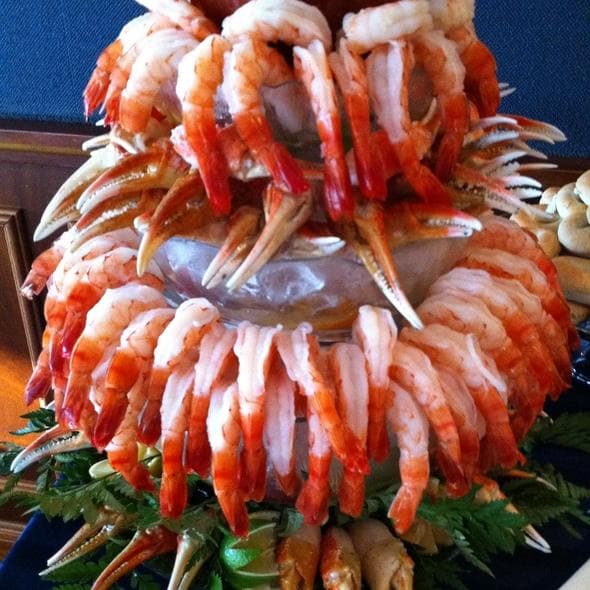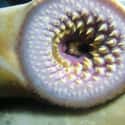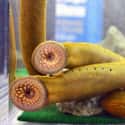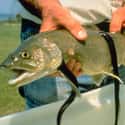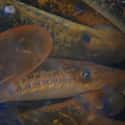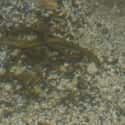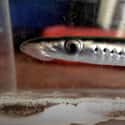-
(#1) Sea Lampreys Are Vampires And Suck The Life Out Of Their Prey
The sea lamprey is nicknamed the vampire of the sea, and for good reason. Their wide suction cup mouths allow them to cling onto their host and feed for a prolong time. The lamprey generally vacuums itself onto one spot of their victim's body, making it an effective method to sucks their prey’s bodily fluids and blood. In addition, the proteins in their saliva widen the blood vessels of their prey while their abrasive tongue and piercing teeth damage the skin of its victim and induce blood flow. This allows the lamprey to consume more nutrients and nourishment in a short amount of time
-
(#2) Lampreys Are Jawless Fish With A Suction Cup Mouth
The sea lamprey has a wide-open mouth that is filled with rows of sharp teeth, formed in a circular setting. This allows the lamprey to suction and anchor itself tightly onto its prey for feeding or a rock for resting. In fact, the lamprey belongs to a superclass of jawless fish known agnathans. Creatures in this group exclude gnathostomes, which are vertebrae species with jaws. The unique thing about the agnathan class is that it’s a prehistoric group that is largely extinct. In fact, only two spices of agnathan survive today: the hagfish and the lamprey.
-
(#3) Lampreys Have Amazing Regeneration Powers
Lamprey fish possess the unique ability of regeneration within their bodies. They share this ability with various creatures such as crabs, sea stars, salamanders, scorpions, and some lizards to name a few. These creatures can regenerate their systems, appendages, or bodily fluids in some form. If a lamprey’s spinal cord becomes completely severed, leaving the creature immobile, they can recover to full mobility again in 10 to 12 weeks. Because the sea lamprey can regenerate some of their long nerve connections, they can heal the injured part of their spinal cord.
-
(#4) Parasitic Sea Lamprey Destroy The Environment
The sea lamprey is considered to be a parasitic fish because it bores holes into its prey while feeding on their blood and bodily fluids, slowly killing their prey and damaging the species overall survival rate. In fact, a single parasitic lamprey can kill over 40 pounds or more of fish in its lifetime.
The impact that sea lampreys pose to the ecosystem greatly threatens the lives of the many fish it prefers to feed on, such as the lake sturgeon. Because of the sea lamprey's horrendous feeding habits on lake sturgeons, the sturgeon has been marked on the threatened and endangered species list in both New York and Vermont.
-

(#5) They're Really, Really Hard To Stop
Because of the invasive nature of the sea lamprey and after the destruction they caused during the 1940s, conservationists searched for a method to cull the lamprey population. The barriers that were first used to stop the lampreys from reaching the lakes proved to be ineffective. It wasn’t until much later, in the latter half of the 1950s, that biologists created an effective poisonous chemical to control the sea lamprey population, called Lampricide. Lampricide is non-toxic to humans or other aquatic life and only works to kill lamprey in their larval stage. Since then, new techniques such as male lamprey sterilization and pheromone communication methods have been used and prove to be effective as well.
-

(#6) Fish Attacked By Lampreys Have Low Survival Rate
If you're a fish and you get attacked by a sea lamprey, odds are you won't survive. Lampreys love fresh and saltwater fish, including trout, chubs, salmon, sharks, catfish, and some small invertebrates. Approximately one out of seven fish a sea lamprey feeds on may survive. The lamprey’s salvia carries anticoagulant properties, which will prevent a victim's wound from clotting and healing. This allows for more blood loss and serious infections to set in, which inevitably kills the fish. So if the sea lamprey doesn't suck its victim dry right away, the injuries it leaves behind are more than likely going to kill whatever fish it latched.
-
(#7) Sea Lampreys Nearly Collapsed Commercial And Recreational Fishing
During the 1940s and 1950s, an explosion of sea lamprey wreaked havoc to the Great Lakes. The invasive species excessively fed on the lake trout, whitefish, and chubs that dwelled there. Because a single adult lamprey can consume a massive amount of fish in its lifetime, a multitude of lamprey feeding on the lake's fish caused a huge epidemic for the commercial and recreational fishing industries. In fact, before the epidemic, more than 15 million pounds of lake trout could be harvested on a yearly basis from the Great Lakes. However, after the invasion, this number fell dramatically and by the 1960’s only 300,000 pounds was harvested from the lakes.
-
(#8) Did Lamprey Meat Kill King Henry I?
Who would eat a scary fish like the lamprey, right? Actually, as far back as medieval times, the lamprey fish was considered to be a consumable food source and was generally cooked in their own blood with a profuse amount of wine. The lamprey was recorded to be one of King Henry’s (Henry I) favorite meals. In fact, it’s even believed to be the cause of King Henry’s death. However, today lamprey meat is considered a delicacy or necessity in Asia, Portugal, Spain, and Alaska. The market value for live lamprey is around $25 per pounds.
-

(#9) Lampreys Have Been Alive For 360 Million Years
According to recorded lamprey fossil discoveries, scientists have determined the lamprey species is more than 360 million years old. A lamprey fossil is a rare find because their skeletal systems are made of cartilage, which often doesn’t fossilize as easily as bone does. The fossilized skeletal system from ancient lampreys in comparison to today’s lampreys doesn’t show any great form of anatomical evolution - except they’ve grown a little longer in length. This non-anatomical change generally means the lamprey is as primitive now as it was back in the times when dinosaurs walked the earth.
-

(#10) Lampreys Aide Scientist In Modern Medicine
Because of the sea lamprey's genome, which allows them the amazing ability to regenerate nerve endings and regain full motion, the species has become a valuable research subject for scientists. In fact, scientists studying the sea lamprey genome have discovered some genes are linked to human neurological disorders. With this information, more tests and further studying, scientists hope to find cures to restore damaged nerve endings in humans and assist patients suffering from spinal cord injuries, Alzheimer’s, and Parkinson’s diseases. Aside from vertebrae and nerve restoration, the lamprey genome is also being studied for embryonic development and organ differentiation research.
-
(#11) Sea Lampreys Only Have One Enemy - Humans
Besides humans, there are no other known predators that hunt sea lampreys. This gives the lamprey a great advantage towards strengthening their species and living fuller lives. However, they aren’t exempt from hosting parasitic invaders that could inevitably kill them. Studies conducted from select regions of the Great Lakes found most lampreys carried mild traces of nematode parasites and only proved to be damaging towards the end of a lamprey’s life. The two most common nematodes lamprey are known to carry are roundworms and flatworms. Still, out of the two parasites, roundworm infestations are reported as being the only parasitic invader to cause the most severe damage to lamprey.
-

(#12) Lampreys Die After Spawning
In spring, sea lampreys makes their way to freshwater riverbeds for breeding. Gathering in small groups, the females will lay between 35,000 to 100,000 eggs, which the male fertilizes externally. After fertilization, the eggs are buried in shallow nests within the stony riverbed. For sea lampreys to reproduce during the spawning season, they stop eating to conserve energy. As reproducing adults, sea lampreys no longer need their digestive track, and so it deteriorates to make room for their reproductive system. This weakens the lamprey and allows its body to become invaded by a fungus, which immediately kills the lamprey shortly after spawning.
-
(#13) Not All Lamprey Fish Are Parasitic
The sea lamprey is not the only type of lamprey living in the world. In fact, there are over 40 different species of lampreys that exist on earth. Four of these species are native to North America. And while the invasive, parasitic lampreys get the most attention, not all lamprey fish are parasitic or invasive to the environment. The northern brook and American brook lamprey are non-parasitic. Unlike river and sea lamprey, brook lamprey never become parasitic as adults; they simply mate and die. Non-parasitic lampreys don't deplete the fish population and actually live in balance with the food chain.
-
(#14) Lamprey Undergo Amazing Transformations Into Adulthood
Lamprey larva are known as ammocoetes. When they emerge from their eggs they are born blind and must locate sandy areas to burrow in for protection and to filter feed. Some lampreys will continue to live in their larval stage for up to four years while others will go on longer, well up to 10 years. However, during the mid-to-late summer of their fourth or tenth year, the larva change dramatically inside and out. They develop their suction cup mouths, grow functioning eyes, and their kidneys adapt the ability to withstand saltwater. Once this metamorphosis is fully complete the lamprey is known as transformers and are ready to move into deeper water to feed on fish and mature into full fledge adults.
New Random Displays Display All By Ranking
About This Tool
We can not deny that lampreys look very disgusting. They have no upper and lower jaws, and their cylindrical mouths are full of teeth, which is one of the characteristics of ancient fish ancestors. Scientists have confirmed that lampreys are the most primitive vertebrates in the world, but this sea creature has hardly evolved and still maintains its original form and way of survival. They rely on these sharp teeth to suck blood from other fish, and even parasitize other big fish.
We should know that lampreys are not fish, because they look terrifying and become the prototype of many monsters in movies. In fact, lampreys are also edible and taste good. You could find 14 disgusting facts about lampreys in this random tool.
Our data comes from Ranker, If you want to participate in the ranking of items displayed on this page, please click here.

